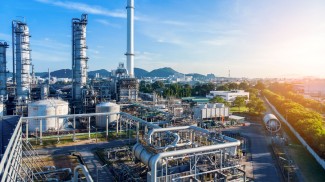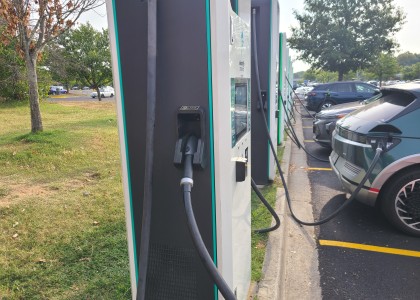States seeking to cut carbon pollution dramatically will need to tackle not only power plants, transportation, and buildings but also industry—responsible for over a quarter of emissions. Some states have nascent efforts in the industrial sector, but the challenges ahead are enormous and complex.
The U.S. Climate Alliance—a bipartisan coalition of 24 governors—commissioned ACEEE to develop a guidebook for states looking to make progress on decarbonizing industry. Published today, the guidebook surveys challenges to industrial decarbonization across the seven industries that produce 80% of emissions in this sector: chemicals, petroleum refining, iron and steel, cement, glass, forest products, and food and beverage. It highlights over 100 efforts underway in several leading states and presents a set of options for states seeking to expand or accelerate their efforts in this emerging but significant policy space.
Tackling industrial emissions through pillars of decarbonization
Tackling industrial emissions is challenging because of the sector’s complexity, the high degree of capital investment needed to transition to low-carbon or decarbonized technologies, and the long lifetimes of infrastructure such as plants and equipment. The report points to five main “pillars” of industrial decarbonization: efficiency—a crucial first step toward making the other pillars affordable and feasible; process electrification; low-carbon fuels and feedstocks; carbon capture, utilization, and storage (CCUS); and procurement of low-carbon materials and products. These pillars can set states on the path to net-zero greenhouse gas (GHG) emissions for most industrial activities. Energy efficiency is a foundational pillar that both sets an industry on the decarbonization path as well as leverages additional reductions from other pillars.
Industrial decarbonization requires a multi-layered, multi-stakeholder approach. Industry cannot do it alone; policy interventions and investments from the federal government are foundational. Billions of dollars from the recent Inflation Reduction Act, combined with funding from the Energy Act of 2020, the Infrastructure Investment and Jobs Act of 2021, and the CHIPS Act of 2022, will be a once-in-a-generation catalyst to advance industrial decarbonization. The guidebook shows that states play a critical role in supporting and accelerating the process. Recent efforts made by states across the country rely on five key policy levers—investing in low-carbon infrastructure, leveraging financing, adopting regulations and standards, supporting technical assistance, preferentially purchasing low-carbon products, and supporting worker training programs—and set early examples others can follow to support and advance industrial decarbonization.
Goal setting and planning
State planning is an essential early step. Three states have set some type of target for reducing GHG emissions in the industrial sector specifically. For example, a Colorado law passed last year directs a state commission to adopt rules to reduce industrial GHG emissions in the state by at least 20% by 2030, relative to 2015 levels.
At least seven states have indicated the importance of industrial decarbonization in their climate or energy action plans. But most have not yet evaluated how efficiency, electrification, and low-carbon fuels could cut their industrial emissions, leaving a gap in the baseline knowledge needed for transition planning.
Some states have developed plans, conducted analyses, or set up new governance structures focusing on specific types of industrial decarbonization efforts. For instance, Colorado, New Mexico, and Oregon have analyzed opportunities to deploy low-carbon fuels and feedstocks, including hydrogen.
Colorado is also evaluating how CCUS can help it meet state climate goals; Washington and Minnesota are focusing efforts on public procurement for low-carbon construction materials.
Moving from research to deployment
Research, development, demonstration & deployment (RDD&D) efforts for industrial decarbonization technologies are critical. Much of this effort comes from the federal government and private industry.
States can complement federal efforts via direct investment in RDD&D programs and by supporting innovative companies with tax credits. A California program, for instance, has invested $133 million over 10 years toward research and development efforts that support sustainability in the industrial and agricultural sectors.
Carbon pricing
Carbon pricing policies—such as cap-and-trade programs and carbon taxes—can incentivize companies to invest in low-carbon fuels and energy-efficient practices and technologies, including in the industrial sector. Several states already have these policies or are part of multi-state cap-and-trade programs.
These policies can boost industrial decarbonization in a second way. In several instances, proceeds from these programs have been used to directly support industries’ efforts to reduce emissions. New York used revenues from the Regional Greenhouse Gas Initiative (a cap-and-trade program for the power sector) to help fund the development and demonstration of high-potential GHG emissions reduction technologies for the state’s manufacturing industries.
Providing incentives
Economic incentives are among the most common policy tools governments deploy to promote decarbonization. So far, most state incentives supporting industrial decarbonization have focused on improving energy efficiency in the sector through financial and technical assistance. Energy efficiency programs in Massachusetts, New Jersey, and Wisconsin, for instance, offer a suite of incentives for industrial facilities to invest in energy-saving improvements.
While most state incentive programs for industry are already focused solely on energy efficiency, additional opportunities exist for states to expand these programs and support other industrial decarbonization pillars to amplify emission reductions.
Setting standards
Federal performance standards have proven critical for reducing various air pollutants, including emissions from industry. In theory, states can develop standards to support all pillars of industrial decarbonization.
Some states are in the early stages of developing standards that address material efficiency, carbon capture, and embodied emissions, but little work has advanced to comprehensively capitalize on electrification and other fuel-switching opportunities. Standards that accommodate the needs of small- and medium-sized manufacturers and lighter industry are also missing. States could serve as valuable proving grounds for new types of standards in the industrial sector.
The guidebook also addresses other challenges facing industrial decarbonization policy development. These include administrative complexity, clean energy timing and sequencing, transition costs, environmental impacts, GHG emissions reduction target complexities, and considerations for small and medium manufacturers. Opportunities for success include harnessing regional partnerships across states, targeted work with industrial clusters, and learning and collaboration with federal, state, and international peers to achieve the most efficient transformation while also addressing just transition, workforce development, and diversity considerations.
The path ahead
While the current industrial decarbonization policy landscape is in its early stages, states are in a prime position to take swift and innovative action to help accelerate the sector’s efforts to reach net-zero GHG emissions. The guidebook offers resources and tools for states to learn from their peers, take advantage of collaborative opportunities, and make progress in advancing the development and implementation of productive industrial decarbonization policies.




